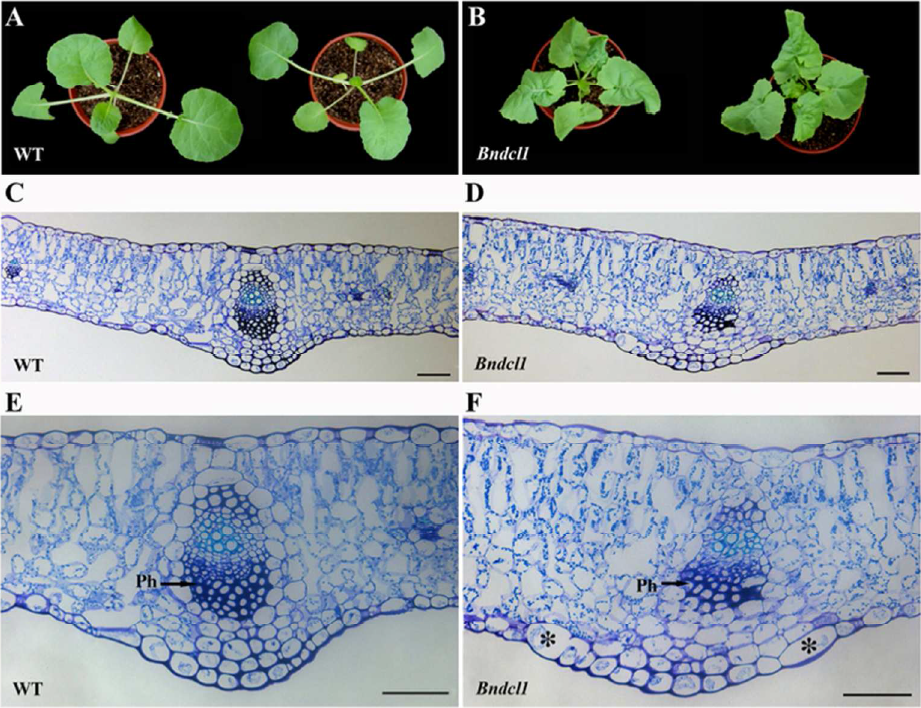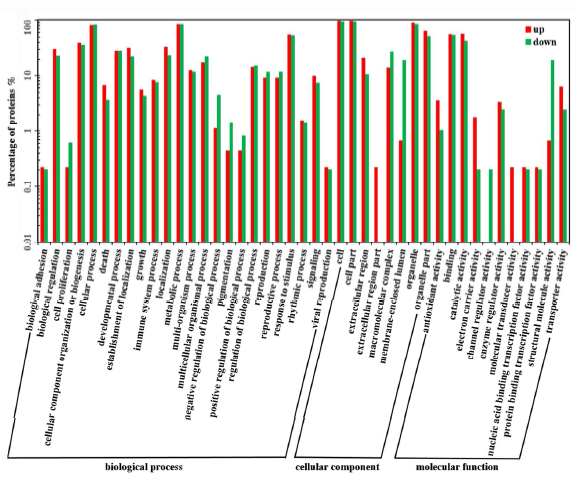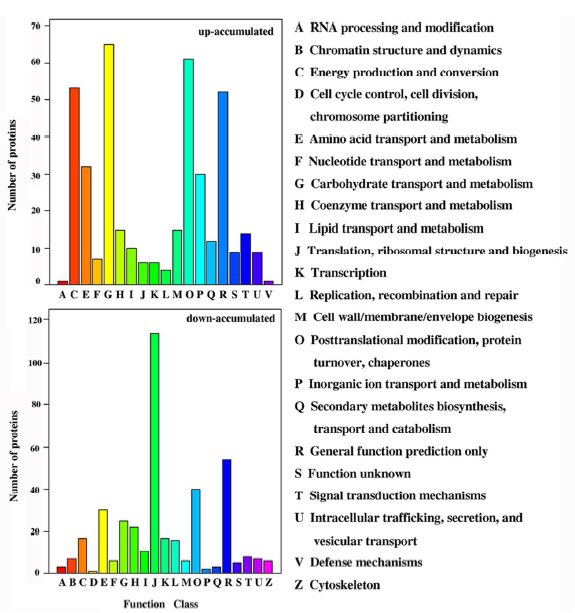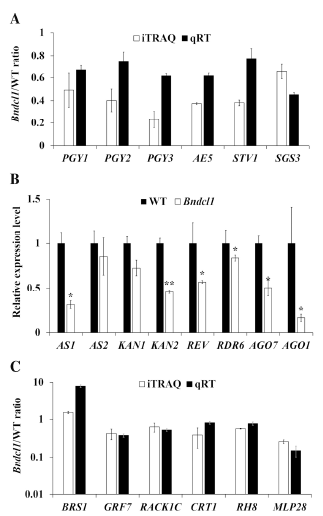Title: Histicological, Physiological, and Comparative Proteomic Analyses Provide Insights into Leaf Rolling in Brassica napus
Journal: Journal of Proteome Research
Impact factor: 4.268
Cooperative Technology: iTRAQ
Background The leaf is the main organ for photosynthesis in most plants, and leaf development affects crop yield and plant structure. Moderately rolled leaves are considered to be an important part of crop ideal breeding. It can change the structure of plants, improve photosynthetic efficiency, delay leaf senescence, and alleviate the damage caused by drought, high temperature and high light. In recent years, coiled leaf mutants have been isolated from Arabidopsis and rice, and their molecular mechanisms have been studied in depth. As one of the most important oil crops in the world, rapeseed has also found some mutants of curly leaves, but its mechanism of action remains to be further studied.
The authors mainly used iTRAQ quantitative proteomics technology to analyze the differential proteins of Brassica napus mutant Bndcl1 and wild strain (WT), and clarified the mechanism of leaf rolling and its physiological effects on plants, which is expected to promote the ideal plant type breeding of rapeseed.
Research content and results
1. In this study, the authors selected the Brassica napus mutant Bndcl1, which was firstly compared by histological comparison. Compared with the wild strain (WT), the mutant phenotype (Bndcl1) had a relatively compact leaf phenotype (Fig. 1A and B). The number of Bndcl1 chloroplasts was significantly increased in the tissue section results, especially in spongy mesophyll cells (Fig. 1C and D). In addition, the authors found that in the Bndcl1 mutant, there were fewer parenchymal cells in the distal axis, and the abaxial end epithelial cells below the leaf vein were significantly enlarged (Fig. 1E and F).

Figure 1. Histological analysis of the leaves
2. To assess the effect of coiled leaves on the photosynthetic properties of Bndcl1 mutants, the authors determined Chl content, Chl fluorescence and gas exchange parameters. The effective quantum yield of chloroplast number, PSII and net photosynthetic rate in the Bndcl1 strain was significantly increased compared to the wild strain.
3. The generation of reactive oxygen species (ROS) is unavoidable in the photoreaction process of photosynthesis, and PSII is highly susceptible to photodamage. The inevitable loss of photoinhibition of photosynthesis is aggravated by the production of ROS, and the production of ROS will slow down the repair of PSII. In order to reduce photooxidative damage, photosynthetic organisms have evolved a variety of mechanisms, and up-regulation of antioxidants is part of the regulatory mechanism. Therefore, the authors examined the enzymatic activity, lipid peroxidation and ROS levels of Bndcl1 and WT leaves, and found that O2•− and H2O2 were lower in Bndcl1 leaves, indicating that their ROS levels would also be significantly reduced (Fig. 2A and B). . In addition, the low level of TBARS at the mutant strain also indicates a decrease in the level of membrane lipid peroxidation (Fig. 2C). The authors also tested the activity of SOD, POD and CAT enzymes in both, and found that this enzyme activity was significantly increased in Bndcl1 leaves compared to WT strains. This shows that Bndcl1's optical system can better avoid photooxidation damage.

Figure 2. Leaf enzyme activity, lipid peroxidation and ROS levels in wild (WT) and mutant (Bndcl1) strains
4. The author applied iTRAQ quantitative proteomics technology to study the difference of protein expression levels between Bndcl1 and WT leaves. A total of 5019 proteins were identified, and there were 943 differential proteins, of which 451 were up-regulated and 492 were down-regulated. . The authors performed annotation analysis on these proteins, such as GO, COG, and KEGG. By performing GO analysis on proteins that are up-regulated and down-regulated in differential proteins, it is found that the number of proteins down-regulated is higher than that of up-regulated proteins in terms of "cell proliferation", "modulation of biological processes", and "pigmentation". The number of up-regulated proteins with a function of antioxidant activity was more than three times that of down-regulated proteins (Fig. 3). COG analysis showed that most down-regulated proteins are involved in translation, ribosome structure and biogenesis, while up-regulated proteins are mainly involved in carbohydrate transport and metabolism, transcriptional post-translational modification, protein turnover, molecular chaperones and energy production and transformation (Figure 4 ). The KEGG annotation results show that although proteins with up-regulated and down-regulated proteins are involved in “metabolic pathwaysâ€, “biosynthesis of secondary metabolites†and “starch and sucrose metabolismâ€, different differential proteins are involved in different pathways. (Figure 5).

Figure 3. Annotation analysis of GO function of differentially expressed proteins 
Figure 4. COG annotation analysis of differentially expressed proteins 
Figure 5. KEGG enrichment analysis of differentially expressed proteins
5. To further classify the functions of these differential proteins, the authors performed a functional enrichment analysis. Through the enrichment analysis of differential proteins, it was found that these up-regulated proteins could improve the photosynthetic performance of Bndcl1 strain and reduce oxidative damage, and found that the down-regulated protein was involved in the near-a-axis polarity formation of the leaves.
6. The authors finally selected multiple proteins from differentially expressed proteins for qRT-PCR expression verification. For example, the genes associated with the leaf-rolling phenotypes PGY1, PGY2, PGY3, AE5, STV1 and SGS3, the protein expression levels of these genes are significantly down-regulated in proteomics results. qRT-PCR verification showed that mRNA expression levels of these genes were significantly decreased in the Bndcl1 strain, indicating that these genes showed consistent changes at the protein and mRNA levels (Fig. 6A). In addition, the authors examined key regulators of leaf polarity at the transcriptional level: AS1, AS2, KAN1, KAN2, REV, RDR6, AGO7, AGO1 (Fig. 6B). It was found that in Bndcl1 strain, AS1 and KAN2 were significantly decreased, AS2 and KAN1 were not significantly changed, and REV was significantly down-regulated. In addition, RDR6, AGO7, and AGO1 also experienced significant downward adjustments. Finally, the authors also verified the transcriptional level of six differentially expressed proteins related to rapeseed sterol, and the results were consistent with the iTRAQ data (Fig. 6C), indicating the reliability of the results obtained by quantitative proteomic analysis.

Figure 6. qRT-PCR validation analysis
Summary of the results This study shows that leaf near-axiaxial polarity and canola sterol metabolism and signaling pathway defects are responsible for the downward curling phenotype of Bndcl1 mutant leaves, and moderate curling of leaves can improve light absorption, energy transfer and The CO2 fixation efficiency, in turn, improves the photosynthetic properties of the mutant strain. In addition, elevated levels of antioxidants and proteins involved in the PSII repair cycle in mutant strains may reduce photosynthetic losses from abiotic stresses. This study provides new insights into the mechanism of canola leaf rolling and the effects of leaf rolling on plant physiology. Therefore, the coiled leaf mutant has a compact structure, which can improve photosynthetic efficiency and enhance stress resistance, which is also an ideal plant type for crop breeding.
Analytical literature
Wenjing Chen, Shubei Wan, et al. Histological, Physiological, and Comparative Proteomic Analyses Provide Insights into Leaf Rolling in Brassica napus. 2018, DOI: 10.1021/acs.jproteome.7b00744
references
1. Yang, C.; Xu, L.; et al. iTRAQ-based proteomics of sunflower cultivars differing in resistance to parasitic weed Orobanche cumana. Proteomics 2017, 17, 1700009.
2. Liang, J.; Liu, B.; et al. Genetic variation and divergence of genes involved in leaf adaxial-abaxial polarity establishment in Brassica rapa. Front. Plant Sci. 2016, 7, 94.
3. Husbands, AY; Benkovics, AH; et al. The ASYMMETRIC LEAVES complex employs multiple modes of regulation to affect adaxial-abaxial patterning and leaf complexity. Plant Cell 2015, 27, 3321-3335.
4. Jia, H.; Shao, M.; et al. Proteome dynamics and physiological responses to short-term salt stress in brassica napus leaves. Plos One 2015, 10, e0144808.
5. Yamaguchi, T.; Nukazuka, A.; Tsukaya, H. Leaf adaxial-abaxial polarity specification and lamina
Outgrowth: Evolution and development. Plant Cell Physiol. 2012, 53, 1180-1194.
Frozen squid whole refers to squid that has been cleaned, gutted, and frozen whole, including the head, body, and tentacles. This type of squid is commonly used in various cuisines, including Asian, Mediterranean, and Italian, and can be prepared in many ways, such as grilling, frying, or boiling. Frozen squid whole is often sold in seafood markets, grocery stores, and online retailers and can be stored in the freezer for several months.
Zhoushan Fudan Tourism CO., LTD , https://www.fudanfood.com